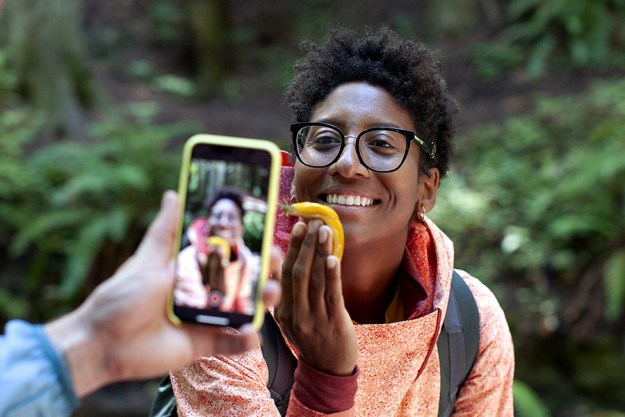
This is a random sampling of my recent digital conversations.

Apparently I’m not the only one who’s replacing words with screenshots and Imgur-made memes. The surplus of photo-favoring apps that have conquered the social space within the last few years are example enough: We’ve all witness the Pinterestification of the Web, the Tumblr takeover of traditional blogging, and we all now know the pure power of Instagram is not to be underestimated.
But this trend in particular simply has its roots in “traditional” visual apps like the aforementioned. Those apps were minimalistic in their nature; they focused on images and photos instead of a text element. Now we’re seeing images, in a variety of forms, replacing text altogether.
Speed is another important factor. I can tell you where I am with a photo faster than I can write it out.
The app of the moment that can very much be tied to the popularity of visual digital communication is, of course, Snapchat. While Snapchat was originally pitched as a tool for “secret” photo-sharing, those days are long over. Now it’s morphed into a messaging app with personality, where users trade inside jokes and personal moments… that come with finger-drawn, crayon-like borders and accessories.
WhatsApp and WeChat have also played a hand in the death of actually “text” messaging. The popular chatting apps let you send photos and emojis and drawings.

This summer, Facebook introduced photo comments, and to say they’ve been well-received would be putting it lightly. These comments rise to the tops, standing out among the pack of likes and word-written approvals. Threads are given new life with images, sometimes devolving to nothing more than to a back-and-forth comprised entirely of pictures. I know I’m not alone here: Whenever I respond to a status update with a photo I received more likes than if I’d attached a link or composed by own response.
“This is a watershed time where we are moving away from photography as a way of recording and storing a past moment,” professor of photography at Harvard, Robin Kelsey, recently told the New York Times. “[We are] turning photography into a communication medium.”
Whereas we used to spend careful time taking photos, editing them, and uploading them to Facebook or Flickr, Instagram taught us all that effort was for naught and that a quick snap and a 30-second filter perusal could churn out beautiful pictures that people interacted with – rabidly. And while our Facebook or Twitter profile pictures require some level of awareness and decision-making (“what will this single photo say to the world about me?”), a just-taken selfie can be fired off via Snapchat, iMessage, Facebook Chat – wherever – to tell, nay, show your friend how you’re feeling. Or who you’re creeping on. Or what you’re doing.
Showing simply carries more weight than telling. A fast inventory of my Facebook Timeline and activity proves as much: I get more interaction from images. I interact more with my friends’ images.

We know very well that we have a visceral reaction to images, but that doesn’t account entirely for our affinity for the picture message. Speed is another important factor. I can tell you where I am with a photo faster than I can write it out; you can explain how your conversation with your boyfriend went with a screenshot of the text better than if you re-composed it yourself and had to write out the “and then I said” and “then he said” over and over.
You have to imagine this will have some sort of effect on our verbal and writing skills. The adverb is already dying quickly (see what I did there?), will the adjective be next? Who needs descriptors when you can see for yourself.
I’m surrounded by these leafy, lush green tre – oh hell, just look for yourself.
That’s not to say the propensity to favor images over text is all bad. Texting in general is a reprieve to our overloaded auditory systems, and for those like myself that spend their days reading, parsing, deciphering written words (and there are still many of us), the to-the-pointness of screenshots and images is something of a relief. It’s the source of the information, no in-between routes taken, nor any reinterpretations (save for the occasional crop, filter, or drawn-on addition… and if you’re friends with particularly malevolent texters, iMessage editing). There’s also evidence that photo messages actually help people express themselves better, and feel more connected to those they are communicating with. And no one can deny the intimacy of sending reaction GIFs back and forth with your best friend all day, or selfies to your long distance significant other.
This is also opening the door for new technology that interprets the text in our images. I recently stumbled across a patent that proposes the ability to interpret the emotions behind a selfie, and assigning it a specific emoticon. It’s quite Dystopian to think about using such a system to define how we’re feeling instead of doing it ourselves, in our words – although we’re already heavily relying on computers to help us convey emotion.
But I digress. I’ve said – er, written – too much.

